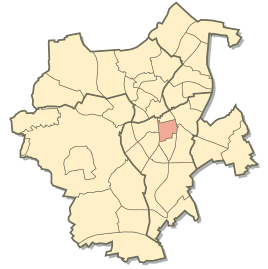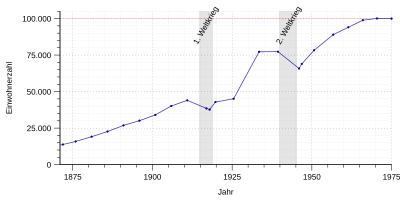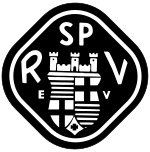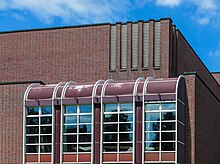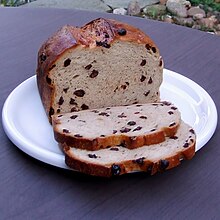Rheydt
|
Rheydt
City of Mönchengladbach
|
|
|---|---|
| Coordinates: 51 ° 10 ′ 3 ″ N , 6 ° 27 ′ 10 ″ E | |
| Area : | 1.45 km² |
| Residents : | 14,364 (Dec. 31, 2018) |
| Population density : | 9,920 inhabitants / km² |
| Postcodes : | 41236, 41238, 41239 |
| Area code : | 02166 |
|
Location of Rheydt in the urban area of Mönchengladbach
|
|
Rheydt is a district of the independent city of Mönchengladbach . Until 1975 Rheydt was an independent city in North Rhine-Westphalia , which was united with the city of Mönchengladbach and the municipality of Wickrath to today's city of Mönchengladbach with the Düsseldorf Act as part of the regional reform in North Rhine-Westphalia on January 1, 1975 .
history
Between 985 and 999 the dioceses of Cologne and Liège exchanged several parishes, including the parochiam Reithe . The origin of the name is uncertain, but is possibly derived from the Old High German riuti ( clearing ). The area on the Lower Rhine was originally Celtic settled in Roman times, is also a settlement proved. At that time the Germanic tribe of the Ubier had been settled here by the Romans .
Rheydt belonged to the Duchy of Jülich-Berg towards the end of the 14th century ; before that, the Margraves Walram von Jülich (1277–1297), Gerhard VII. Von Jülich (1297–1328) and Wilhelm VI ruled . von Jülich (1328–1356). In 1348 the Duchy of Berg came to Jülich. Thereafter, Rheydt developed into subordinate rule with its own administration.
The city belonging to the Prussian Rhine province and the district of Gladbach ( titular city since 1827, final city rights since 1856) became an independent city (Stadtkreis) in the Prussian administrative district of Düsseldorf , on the Niers , on April 1, 1907 . In 1919 the city housed a district court , an upper secondary school with a reform high school, a lyceum, a teacher training college, a trade and trade school for girls, as well as a textile, iron and paper industry and cable works.
On August 1, 1929, Rheydt was united with the independent city of Munich-Gladbach , the city of Odenkirchen (city rights since 1856) and the communities of Giesenkirchen and Schelsen to form the independent city of Gladbach-Rheydt , but already in 1933 at the instigation of the then Reich Propaganda Minister Joseph Goebbels , who came from Rheydt separated again. Thereafter, the Rheydt urban area included the places Rheydt, Odenkirchen, Giesenkirchen and Schelsen.
The heavily damaged inner city was rebuilt according to plans by the architect and architecture journalist Alfons Leitl . A particularly striking element of this rebuilding plan is the ridge development on the main road.
After the Second World War , the German Werkbund was re-established in Rheydt in 1947 . The event, organized by Hans Schwippert , ended with the Rheydter Manifesto .
On September 12, 1968, the population passed the 100,000 mark and Rheydt became a major city . But in 1974 the population fell below this threshold again. On January 1, 1975, Rheydt was finally incorporated into Mönchengladbach.
For the religions in Rheydt see the article Mönchengladbach (Religion) .
Population development
The following overview shows the number of inhabitants according to the respective territorial status. Until 1833, most are estimates, then to census results (¹) or official updates of the respective statistical offices or the City Council itself. The data relate from 1843 to the local attendees population, from 1925 to the resident population and since 1987 the population in the Location of the main residence. Before 1843, the number of inhabitants was determined according to inconsistent survey methods.
|
|
|
Remarks:
- In 2000 Rheydt had a total of 66,283 inhabitants (excluding the places Odenkirchen, Giesenkirchen and Schelsen, which were part of Rheydt up to and including 1974). These were distributed as follows:
- Rheydt-Mitte 42.206 (with Rheydt Castle 29, Bonnenbroich-Geneicken 7015, Rheydt 12.535, Mülfort 9788, Heyden 8382, Geistenbeck 4457)
- Rheydt-West 24.077 (with Pongs 2088, Schrievers 7784, Grenzlandstadion 3003, Schmölderpark 7446, Hockstein 3756)
politics
According to the manorial constitution, the jury and the heads of the six monies belonging to the municipality were at the head of the municipality of Rheydt . They represented the community of Rheydt to the sovereign. In French times, from 1794, there were three members of the municipality . In Prussian times, a mayor headed the city administration, who after 1889 mostly carried the title of mayor . Advice was available to him.
During the time of the National Socialists , the Lord Mayor was appointed by the NSDAP . After the Second World War , the military government of the British Zone of Occupation Dr. Carl Marcus as the new Lord Mayor. From 1938, Marcus worked as secretary to the secret service officer Kurt Jahnke . After his time at Büro Jahnke, a private intelligence service that worked under the patronage of Rudolf Hess and was presumably involved in the preparations for his flight to Scotland in 1941, he later became a German-British double agent with the MI6 cover name Dictionary . In 1947 it was rumored that Marcus had discovered the Grenzlandring race track . After leaving office in 1948, he took on new tasks in the field of cultural policy. In 1946 she introduced the local constitution based on the British model; then there was a city council elected by the people , whose members are known as city councilors . The council initially elected the mayor from among its members as chairman and representative of the city, who was active on a voluntary basis. Furthermore, from 1946 the council elected a full-time senior city director as head of the city administration. This administrative structure existed until the municipal reorganization on January 1, 1975.
Mayor or Lord Mayor 1808–1974
Mayor (and Lord Mayor) of the city of Rheydt
- 1808–1823: Dietrich Lenssen
- 1823–1857: Johann David Büschgens
- 1857–1877: Carl Theodor von Velsen
- 1877–1893: Emil Pahlke (Mayor from 1889)
- 1893–1901: Wilhelm Strauss (Mayor from 1897)
- 1901–1905: Karl Tettenborn (Lord Mayor)
Lord Mayor of the urban district / the independent city of Rheydt
- 1906–1920: Paul Lehwald (Mayor from 1909)
- 1920–1929: Oskar Graemer
- 1929–1930: Franz Gielen (from July 1, 1929 Acting Lord Mayor of Gladbach-Rheydt)
- 1930–1933: Johannes Handschumacher , Center (Lord Mayor of Gladbach-Rheydt)
- 1933– : Wilhelm Pelzer , NSDAP (provisional)
- 1933–1936: Edwin Renatus Hasenjaeger , DNVP , then non-party
- 1936–1940: Heinz Gebauer , NSDAP
- 1940–1945: Alexander Doemens
- 1945– : Heinrich Vogelsang (independent)
- 1945– : August Brocher (center)
- 1945–1948: Carl Marcus ( CDU )
- 1948–1950: Heinrich Pesch (CDU)
- 1950–1956: Johannes Scheulen (CDU)
- 1956–1961: Wilhelm Schiffer ( SPD )
- 1961–1963: Friedrich Hinnah
- 1963–1964: Fritz Frame (CDU)
- 1964–1969: Wilhelm Schiffer (SPD, from 1969 FWGWS) (for the second time)
- 1969–1974: Fritz Rahmen (CDU) (for the second time)
City directors 1946–1974
- 1946– : Ernst Alex
- 1946–1949: Heinrich Raskin
- 1949–1950: Peter Heck
- 1950–1956: Carl Rüther
- 1956–1968: Josef Orth
- 1968–1974: Helmutjoy
coat of arms
| Blazon : “Above a shortened, curved silver (white) tip, inside a black paw cross, quartered; 1 and 4 divided eleven times by gold (yellow) and red, 2 and 3 in gold (yellow) a continuous black cross; in the upper coat of arms a golden (yellow) three-tower wall crown. " | |
| Justification of the coat of arms: The coat of arms used since 1890 was approved by the Prussian King Wilhelm II in 1896 . The paw cross comes from a jury's seal from the 15th century. The shield, which is divided eleven times, is based on the coat of arms of the Lords of Heppendorf , who originally ruled over the city. The Balkenkreuz in the golden shield comes from the coat of arms of the Lords of Bylandt-Rheydt , who ruled Rheydt from 1500 and made the city imperial from 1552 to 1591 . The crown of the wall symbolizes the city charter . |
traffic
From 1956 there was the vehicle distinguishing sign RY of the independent city of Rheydt. In the course of the regional reform in North Rhine-Westphalia, Rheydt was incorporated into the city of Mönchengladbach in 1975 and with the loss of its independence, it also lost its own license plate. A new introduction was last rejected in 2016.
In the core of the old town of Rheydt there are two train stations, Rheydt Hauptbahnhof and Rheydt Güterbahnhof. The latter, however, is only used to park freight trains, special trains for football games in Borussia Park and trains for the Wegberg-Wildenrath test center . Despite its incorporation into the city of Mönchengladbach in 1975, the main station was not renamed, so Mönchengladbach is the only city in Germany to have two main stations.
These two Rheydt stations are on the Aachen – Mönchengladbach railway line and the Iron Rhine , which begins at the main station and runs parallel to the line to Aachen as far as the freight station. The Rheydt – Cologne-Ehrenfeld railway also begins at the main station .
Another passenger station in the area of the former city of Rheydt is the Rheydt-Odenkirchen station, which is on the route to Cologne. Until the 1980s, the Mönchengladbach – Stolberg line ran between the Rheydt-Odenkirchen station and Mönchengladbach Hauptbahnhof on a route parallel to the line between Mönchengladbach Hauptbahnhof and Rheydt Hauptbahnhof via the Rheydt-Mülfort and Rheydt-Geneicken stations . Of this route, only the section between Mönchengladbach Hauptbahnhof and Rheydt-Geneicken, which is used for freight traffic, remains today.
The public transport in Rheydt is apart mainly by buses from the railway mobile and active NEW done. Rheydt is a district of Mönchengladbach in the tariff area of the Verkehrsverbund Rhein-Ruhr . In the past, local transport in the city was provided by the Rheydt tram (1881 to 1959) or the Rheydt trolleybus (1952 to 1973) from Stadtwerke Rheydt.
Events
Since 2006 is Rheydt Castle , the summer music Schloss Rheydt listed. Musicians from the fields of classical, rock, pop, jazz, swing and beat perform over a period of one week. Local groups from Mönchengladbach as well as internationally known artists are represented. In 2011, Gilbert O'Sullivan made his only appearance there in North Rhine-Westphalia.
In Rheydt is within the Rheydter flower processions the Golden Flower of Rheydt awarded. The award is considered the oldest German environmental protection award.
Sports
One of the well-known Rheydt clubs is Rheydter SV , also known as Spö . In 1950, the football team was promoted to the Oberliga West under the direction of player-coach Fritz Pliska , which was the top division at the time. After relegation in 1952, under coach Hennes Weisweiler in 1953, the direct resurgence followed, but one year later they descended again into the second division. In 1965 the 1st hockey team rose to the major league. Rheydter SV plays its games in the Jahnstadion . The men's hockey team played in the 2nd Bundesliga West in the indoor season 2008/09 and in the 2nd Bundesliga North in the 2008/09 field season.
Also in Rheydt is the Grenzlandstadion , where Borussia Mönchengladbach's U23 team plays their games.
Attractions
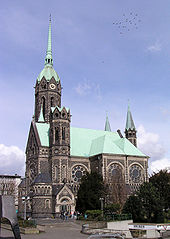
- Town houses on today's Endepohlstrasse, built according to designs by Robert Neuhaus in the late 19th century
- Evangelical Peace Church (today residential building), Rheydt-Geneicken, built 1864–1866 according to a design by Maximilian Nohl in the neo-Gothic style
- Evangelical main church Rheydt , built 1899–1902 according to a design by Johannes Otzen in the neo-Romanesque style and the interior designed according to the Wiesbaden program ; 1943/1944 damaged by bomb attacks, 2004 restoration of the interior with extensive restoration of the painting removed in 1962 with influences from Art Nouveau (organ by the organ builder Wilhelm Sauer from Frankfurt an der Oder)
- Vocational school, Mönchengladbach-Rheydt-Mülfort, built 1938–1955 based on a design by Emil Fahrenkamp
- Catholic Church of St. Franziskus, Rheydt-Geneicken, built 1932–1933 based on a design by Dominikus Böhm
- Catholic parish church St. Marien, built 1853–1855 according to a design by Vincenz Statz in neo -Gothic style , after the Second World War it was rebuilt and remodeled by Alfons Leitl
- Pahlkebad, Mönchengladbach-Rheydt, built in 1969, named after Emil Pahlke (1889–1893 Lord Mayor of Rheydt), closed since January 2008 due to the need for renovation, since April 2008 a listed building, reopened in 2012 after successful renovation
- Rheydt town hall , built 1894–1896 according to a design by Robert Neuhaus in neo-Gothic style
- Rheydt Castle , origins in the 12th century, mansion built 1534–1572 based on a design by Maximilian Pasqualini, during the Nazi era it was converted into a guest house for Joseph Goebbels by Emil Fahrenkamp
- Rheydt town hall, built 1928–1930 according to a design by city master builder Walter Fischer, remodeling 1982–1984 according to plans by HPP
Specialties
- Onjeschwedde or Ongeschwedde is originally a Rheydter, but also a Wickrath bread specialty, which has been available for many years from various traditional bakeries in a somewhat wider area. The yeast bread made from fresh and therefore still "sweatless" ( onjeschwedde ) rye flour (approx. 40%), mixed with wheat flour (approx. 60%), currants and cinnamon , can only be bought immediately after the rye harvest, for about six weeks between End of July and end of September, depending on the weather and harvest time.
Personalities
- Johann Wilhelm Preyer (born July 19, 1803; † February 20, 1889 in Düsseldorf), artist
- Louise Preyer (* 1805; † 1834 in Eschweiler), artist
- Ernst Lenßen (* 1837; † after 1889), chemist
- Hugo Junkers (born February 3, 1859 - † February 3, 1935 in Gauting), entrepreneur and aircraft designer
- Hermann Hirsch (born June 4, 1861; † March 1, 1934 in Göttingen), painter and sculptor
- Alexander Frenz (born October 13, 1861; † 1941 in Düsseldorf), modern painter
- Ludwig Schmitz-Kallenberg (born June 10, 1867, † April 22, 1937 in Münster), historian, professor at the Westphalian Wilhelms University and director of the Münster State Archives
- Ernst Jakob Christoffel (born September 4, 1876, † April 23, 1955 in Isfahan), theologian and founder of the Christoffel Mission for the Blind
- Clara Grunwald (born June 11, 1877; † April 1943 in Auschwitz), Montessori teacher
- Leo Raape (born June 14, 1878; † December 7, 1964 in Hamburg), legal scholar
- Otto Beckers (born October 7, 1879; † unknown), Prussian senior teacher and educational policy author
- Wilhelm Momma (born November 26, 1880 - † May 23, 1930 in Velbert), writer
- Paul Berglar-Schröer (born February 26, 1884, † September 12, 1944 in Darmstadt), writer
- Paul Aretz (born April 1, 1890 - † November 5, 1949 in Bern), publisher, bookseller and author
- Josef Arndgen (born February 24, 1894 - † September 20, 1966 in Wiesbaden), politician (CDU)
- Werner Gilles (born August 29, 1894 - † June 23, 1961 in Essen), artist
- Heinz-Eduard Menche (born March 6, 1886 - † December 25, 1961), naval officer, rear admiral of the Reichsmarine, last used in World War II
- August Bach (born August 30, 1897; † March 23, 1966 in Berlin), journalist and CDU politician in the GDR
- Joseph Goebbels (born October 29, 1897 - May 1, 1945 in Berlin), politician (NSDAP), Nazi propaganda minister
- Peter Erkens (born July 24, 1898 - † October 22, 1972 in Mönchengladbach), politician (CDU)
- Alfred Kamphausen (born March 31, 1906, † November 11, 1982 in Kiel), art historian and museum director
- Artur Petzoldt (born June 2, 1908; † 1972), President of the Hamburg Federal Railway Directorate
- Otto Hartloff (born February 25, 1909, † February 24, 1977 in Kusel), artist
- Emil "Teddy" Vorster (* 1910; † 1976), owner / managing director of the Rheydter silk weaving mill CC Bang, racing driver and president of the German Motorsport Association
- Liesel Frenkel (born April 12, 1915 - March 30, 2018 in Düsseldorf), survivor of the Shoah, autobiographical contemporary witness
- Johannes Botterweck (born April 25, 1917 - † April 15, 1981 in Bonn), theologian
- Heinz Sielmann (born June 2, 1917 - † October 6, 2006 in Munich), animal filmmaker
- Ruth Lommel (born May 6, 1918 in Breslau; † June 22, 2012 in Mönchengladbach), actress; lived in Rheydt as the wife of Emil Vorster
- Hans Helmut Eßer (born March 24, 1921; † January 13, 2011 in Detmold), professor of Reformed theology, moderator of the Reformed League from 1973 to 1982
- Ernst Wilhelm Handschumacher (born November 30, 1924 - † November 14, 2014 at Gut Reichenstein, Monschau), lawyer, Mayor of Meerbusch (1970–1979)
- Heinz Kremers (born October 19, 1926 - † May 26, 1988 in Moers), Protestant theologian
- Hermin Esser (April 1, 1928 - April 17, 2009), opera singer
- Karl Heinz Beckurts (born May 16, 1930, † July 9, 1986 in Straßlach), nuclear physicist
- Alexander Arnz (born August 25, 1932; † September 30, 2004 in Cologne), television director
- Manfred Sachse (born August 8, 1935 in M. Gladbach), blacksmith, author and recognized expert on Damascus steel; lived in Rheydt from 1946 and restored historical weapons for the Museum Schloss Rheydt
- Uwe Erichsen (born August 9, 1936), writer
- Meinhard Classen (born August 12, 1936 - October 6, 2019), physician (gastroenterology and endoscopy)
- Hilmar Hoffer (born November 14, 1937), former football player
- Andreas Birkmann (born August 14, 1939), politician (CDU)
- Rolf Herings (born July 10, 1940 - September 29, 2017), athlete and football coach
- Dieter Pauly (born February 14, 1942), former first division football referee
- Gerd Theißen (born April 24, 1943), New Testament scholar
- Klaus Stoll (born May 24, 1943), double bass player and university professor
- Peter H. Krammer (* 1946), immunologist and cancer researcher
- Jürgen Aretz (born February 10, 1946), former State Secretary
- Kajo Breuer (born July 19, 1948), local politician (Greens) and former acting Lord Mayor of Saarbrücken
- Hildegard Wester (born December 28, 1949), politician (SPD)
- Günter vom Dorp (born October 17, 1950 in Mönchengladbach), radio presenter and author
- Gabriele Schrey-Vasara (born October 25, 1953), translator from Finnish
- Nik Ebert (* 1954 in Kędzierzyn), caricaturist; grew up in Rheydt
- Peter Riemer (born March 20, 1955), classical philologist
- Axel Bendung (born August 21, 1957), music producer
- Volker Pispers (born January 18, 1958), cabaret artist and author
- Harald Zillikens (born June 4, 1959 in Rheydt-Odenkirchen), local politician (CDU), mayor of Jüchen
- Tobias H. Strömer (born May 1, 1960), lawyer and author
- Jürgen Wieshoff (* 1961), journalist, author and inventor
- Bernd Mey (born May 7, 1961 in Lindau on Lake Constance), architect; lived in Rheydt until he was 18
- Peter Rütten (born June 30, 1962), comedy writer and actor
- Michael Koch (born December 12, 1964), judge
- Ellen Lohr (born April 12, 1965 in Mönchengladbach), racing driver
- Svenja Pages (born August 3, 1966), actress
- Heinz-Harald Frentzen (born May 18, 1967 in Mönchengladbach), racing driver
- Bernd Kardorff (born December 31, 1967), physician and book author
- Axel Ockenfels (born February 9, 1969), economist
- Gregor Schneider (born April 5, 1969), artist
- Mario Kaiser (born April 8, 1970), journalist and author
- Ansgar Heveling (born July 3, 1972), politician (CDU), Member of the Bundestag
- Sonja Oberem (born February 24, 1973), triathlete and long-distance runner
- Nick Heidfeld (born May 10, 1977 in Mönchengladbach-Rheydt), racing driver
- Charlotte Roche (born March 18, 1978 in London), television presenter; former student of the Hugo-Junkers-Gymnasium in Rheydt
- Summer Cem (born April 11, 1983 in Mönchengladbach-Rheydt, Cem Toraman ), rapper
- David Wallen (born April 30, 1983 in Mönchengladbach), former American football player; grew up in Rheydt
- Marc-André ter Stegen (born April 30, 1992 in Mönchengladbach-Rheydt) goalkeeper, currently at FC Barcelona
- Shakuntala Banerjee (* 1973 in Mönchengladbach-Rheydt) TV journalist and reporter
literature
- Günter Erckens: Rheydt as it was . Droste-Verlag, ISBN 3-7700-0501-5 .
- Schmitz, Ludwig and Wilhelm Strauss: Rheydter Chronik. Volume 1: History of the Rheydt Lordship. Volume 2: History of the city of Rheydt with the supplement: The town hall of Rheydt. Unchanged reprint of the 1897 edition, with a foreword by Wolfgang Löhr. Mönchengladbach, Antiquariat am St. Vith, 2001.
- Christoph Waldecker : Rheydt 1815–1974 . In: Loca Desiderata. History of the City of Mönchengladbach Volume 3/1. Cologne 2003. pp. 241-372.
Web links
swell
- ↑ https://www.moenchengladbach.de/fileadmin/user_upload/statistik/Bevölker_nach_Stadtbezirken_und_Stadtteile__12_2018.pdf
- ^ Federal Statistical Office (ed.): Historical municipality directory for the Federal Republic of Germany. Name, border and key number changes in municipalities, counties and administrative districts from May 27, 1970 to December 31, 1982 . W. Kohlhammer, Stuttgart / Mainz 1983, ISBN 3-17-003263-1 , p. 291 .
- ↑ Kurt Jahnke - Secret Agent in Rudolf Heß's Services (English) ( Memento of the original from October 7, 2007 in the Internet Archive ) Info: The archive link was automatically inserted and not yet checked. Please check the original and archive link according to the instructions and then remove this notice.
- ↑ Ulrich Schlie, Carl Marcus (1911–1989) and the Jahnke office in the crosshairs of Anglo-American services in World War II , in: Reinhard Dörries, Diplomats und Agenten. Intelligence Services in the History of German-American Relations , Winter, Heidelberg 2001, pp. 85–111 (see review by H-Soz-u-Kult ).
- ↑ Carl Marcus. (No longer available online.) In: statesecrets.co.uk. October 7, 2007, archived from the original on October 7, 2007 ; accessed on August 13, 2020 (English).
- ↑ The Grenzlandring
- ↑ Cultural politicians in reconstruction
- ↑ https://www.darc.de/fileadmin/_processed_/d/d/csm_hinten_fa8d4b7f69.png Coat of arms of Rheydt, Wickrath and Mönchengladbach
- ↑ Stadler, Klemens, Deutsche Wappen, Volume 7, Bremen 1972, p. 83
- ^ Rp Online: Mönchengladbach: No own registration number for Rheydt. In: rp-online.de. June 16, 2016, accessed June 5, 2019 .
- ↑ RSV: 100 years of the Spielverein in the overview on www.rheydter-sv.de.

